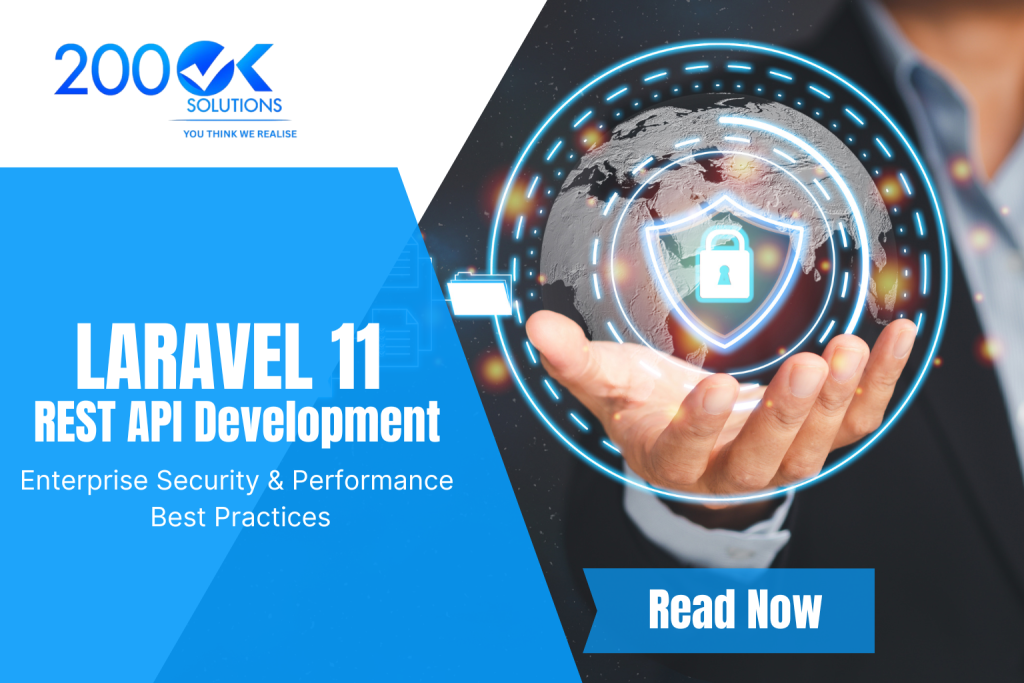
Laravel has established itself as one of the most powerful PHP frameworks for building robust REST APIs. With the release of Laravel 11, developers now have access to even more streamlined tools, performance improvements, and enterprise-level security features. But building an enterprise-ready API requires more than just scaffolding routes—it demands security-first design, optimized performance, and scalable architecture.
In this article, we’ll explore the best practices for Laravel 11 REST API development with a focus on enterprise-grade security and high performance.
1. Design REST APIs with Standards in Mind
Before diving into code, ensure your API follows widely adopted standards.
- Use REST conventions: Stick to nouns for endpoints (/users, /orders) and HTTP verbs (GET, POST, PUT, DELETE).
- Version your API: Prefix endpoints with /api/v1/ to avoid breaking changes when future versions are released.
- Use consistent responses: Structure JSON responses with data, message, and errors for predictability.
Example response:
{
"success": true,
"message": "User created successfully",
"data": {
"id": 1,
"name": "John Doe"
}
}2. Authentication & Authorization
Security begins with proper access control. Laravel 11 makes it easier than ever:
- Use Laravel Sanctum or Passport for API authentication. Sanctum is lightweight and great for SPAs or mobile apps, while Passport works best for full OAuth2 flows.
- Role-based authorization: Use Laravel’s Gate and Policy system to ensure users can only access data they own or are permitted to.
- JWT (JSON Web Tokens): For stateless APIs at scale, JWT provides a secure, decentralized authentication method.
Example of protecting routes with Sanctum:
Route::middleware('auth:sanctum')->get('/user', function (Request $request) {
return $request->user();
});3. Input Validation & Sanitization
Never trust client-side data. Laravel 11’s validation system ensures data integrity:
$request->validate([
'email' => 'required|email|unique:users,email',
'password' => 'required|min:8|confirmed',
]);- Always sanitize inputs (e.g., remove scripts to prevent XSS).
- Use FormRequest classes for cleaner validation logic.
- Return descriptive error messages in JSON format.
4. Secure Your API
Key security measures for Laravel 11 REST APIs:
- Rate limiting: Use Laravel’s ThrottleRequests middleware to prevent brute-force attacks.
- CSRF protection: For stateful APIs, always enable CSRF tokens. For stateless APIs, rely on tokens or JWT.
- HTTPS only: Force SSL to prevent man-in-the-middle (MITM) attacks.
- Encrypt sensitive data: Use Laravel’s built-in Crypt or hashing (bcrypt, argon2id).
- Avoid exposing stack traces: Set APP_DEBUG=false in production.
5. Optimize Database Performance
APIs often fail at scale due to database bottlenecks. Follow these tips:
- Use Eloquent wisely: Avoid N+1 queries with with() eager loading.
$orders = Order::with('items')->get();- Pagination: Never return massive datasets; use Laravel’s paginate().
- Database indexing: Optimize queries with proper indexing.
- Caching: Use Laravel Cache (Redis/Memcached) for repeated queries.
6. Caching & Response Optimization
Performance is key in enterprise applications.
php artisan route:cache- Config caching:
php artisan config:cache- HTTP caching: Use ETags, Last-Modified headers, or Laravel’s Cache::remember() for frequent responses.
- Response compression: Enable Gzip or Brotli compression on the server.
7. Logging & Monitoring
For enterprise systems, real-time monitoring is essential.
- Centralized logging with Laravel’s Monolog integration.
- API activity logs: Track which endpoints are being accessed.
- Error monitoring: Integrate with services like Sentry, Bugsnag, or New Relic.
8. Testing & CI/CD
Automated testing ensures API reliability.
- Feature tests: Use Laravel’s HTTP testing methods (getJson, postJson) for endpoint tests.
$response = $this->postJson('/api/v1/users', ['name' => 'John']);
$response->assertStatus(201);- Continuous Integration: Automate testing and deployments with GitHub Actions, GitLab CI, or Jenkins.
- API documentation: Generate Swagger/OpenAPI docs for internal and external teams.
9. Scaling for Enterprise
As your API grows, scalability becomes critical:
- Horizontally scale with load balancers.
- Use queues for heavy tasks (emails, reports) with Laravel Queues & Horizon.
- Microservices architecture: Break large APIs into services connected via events or message queues (e.g., Kafka, RabbitMQ).
- Database sharding & replication for large-scale apps.
Conclusion
Building a REST API with Laravel 11 goes far beyond routing and controllers. To deliver an enterprise-ready solution, you must prioritize security, performance, scalability, and maintainability from day one. By following these best practices—secure authentication, input validation, database optimization, caching, and monitoring—you’ll ensure that your Laravel 11 API can scale reliably and remain secure against evolving threats.

